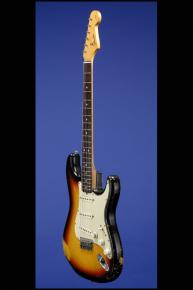An Excellent 1965 L Series Hardtail Stratocaster
This is one of the the lightest Stratocasters that we have ever seen -- it weighs just 6.70 lbs. and has a nice fat nut width of just under 1 11/16 inches, a medium neck profile, and a scale length of 25 1/2 inches. One-piece alder body, contoured on back and lower bass bout, maple neck, and veneer rosewood fretboard with 21 frets and pearloid dot position markers. Small headstock with "transition" logo. Single "butterfly'"string tree. Individual "two-line" Kluson Deluxe tuners with oval metal buttons (stamped inside "D-169400 / Patent No"). Neckplate with four screws and serial number ("L71636") at the top. Three white plastic-covered staggered-height pole pickups with balanced outputs of 6.15k, 5.58k, and 5.54k. Three-layer white plastic "green" pickguard with eleven screws. Three white plastic knobs (one volume and two tone) plus three-way selector switch. Six-pivot bridge unit with through-body stringing. The end of the neck is stamped "2APR65B" and there is a "C" written in marker following the date stamp. The pickups are all dated "5-3-65," and the pots are dated "1376514" (CTS, April 1965). There is a moderate amount of belt buckle wear on the back, some surface wear on the back of the neck, an area of wear on the top where the player's arm has rested, a few marks on the sides, and some light lacquer checking. There is a very small split in the pickguard by the bass side adjustment screw of the neck pickup, and also a former owner has very neatly enlarged the half-moon cutout on the pickguard between the bass pickup and the neck to allow better access to the truss-rod adjustment screw. The frets are original and have plenty of life left in them. Inside the control cavity are the letters "C.Y.4 /?" which are burned into the body with a soldering iron tip at the Fender factory. This type of marking was usually burnt into the top of the body under the pickguard to signify a factory re-visit for adjustment/repair or a custom-color re-finish. We have never seen these letters burnt into the control cavity before, and can only assume that it meant something to the original Fender employee that assembled the guitar. The finish is certainly all original and this guitar is a wonderful example, totally original, and a fantastic player. Housed in it's original Fender black hardshell case with dark orange plush lining.
The Stratocaster was launched in 1954 -- samples around May and June were followed by the first production run in October - and it was priced at $249.50 (or $229.50) without vibrato. This new Fender guitar was the first solid body electric with three pickups (Gibson's electric acoustic ES-5, introduced five years earlier, had been the first overall). The Stratocaster also featured a newly designed built-in vibrato unit (erroneously called a "tremolo" by Fender and many others since), to provide pitch-bending and shimmering chordal effects for the player. This was the first self-contained vibrato unit: an adjustable bridge, tailpiece, and vibrato system all in one. Not a simple mechanism for the time, but a reasonably effective one. Fender's new Stratocaster vibrato also had six bridge-pieces, one for each string, adjustable for height and length. The Stratocaster came with a radically sleek, solid body, based on the shape of the earlier Fender Precision Bass, contoured for the player's comfort, and with a yellow-to-black sunburst finish. Even the jack socket mounting was new, recessed in a stylish plate on the body face. The Fender Stratocaster looked like no other guitar around -- and in some ways seemed to owe more to the contemporary automobile design than traditional guitar forms, especially in the flowing, sensual curves of that beautifully proportioned, timeless body.
Translate:










